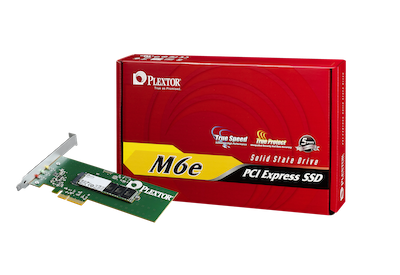My afternoon with the Plextor M6e PCIe SSD


I must go down to the lab again, to the lonely racks and the wires,
And all I ask is a fast server and an image to steer her by;
And the mouse’s kick and the fan’s song and my tired hand’s shaking,
And a grey plate on the system’s face, and a grey cover opening,...
You might recognize those slightly altered lines from the beginning of John Masefield's Sea Fever poem*—a tale told by a man who's in love with life on the sea. Well, in a landlocked state, my sea is the datacenter, or in this particular case, a server lab. My original intent upon making my way down to the lab was to check out a system that gave us a login prompt but wouldn't allow us to login.
After checking it out, I determined that it needed a quick reimage. While there, I discovered that another of our systems had failed to reboot, remaining at the "Press F1 to reboot or press F2 to enter Setup". It was an endless loop.
What I found was that the RAID controller had failed in the old Dell 1950. But all was not lost because Plextor had been kind enough to send me a 256GB M6e PCIe SSD for review. What better review is there than putting the drive to work in a failed system? Of course the system in question was on the very top shelf of our makeshift rack, which is close to seven feet high. Thank goodness the 1950 is a 1U system. The SSD was still in the box, still in the static-free bag just like the day it was shipped to me a couple of months or so ago (Sorry Plextor—time, it seems, is not on my side).
Adding the Plextor M6e to the system was as easy as adding any other card to a computer. Open the case, pop it in, close the case, hoist the system back up onto the top shelf, plug everything back in, and power it on. The Plextor disk shows up just after the CPU and memory check. The Plextor logo and a few drive details display on the screen for what seems like an eternity**.
Once the system passed its POST, it booted onto the 64-bit CentOS 6.4 DVD, and I began the installation. CentOS found the Plextor SSD without issue and installation took about seven minutes to complete. The time would have been much shorter, but the old DVD drive is slow. After the system rebooted, I logged in, configured my network, and away I went updating the OS and installing a few extra goodies.
Tech Pro Research
The system is incredibly fast, but putting this kind of leading edge disk drive into an old 1950 is like putting a racing engine into a 1965 VW Beetle. Yes, it's faster, but it's still a 1965 VW Beetle. To get the full benefit, you'd have to upgrade the transmission, tires, rear-end, and so on.
But putting a racing engine (Plextor M6e SSD) into the Beetle (Dell 1950) isn't the point. The fact that it works and that it works without issue is the cool part. It's an upgrade from the old PERC and 70GB SCSI drives. And what an upgrade for just over $250 it is. Sure, that old 1950 is past its prime for production purposes, but for a test/dev system, it's just fine. It's a good 64-bit system that can still deliver a punch when you need for it to, especially with CentOS, Ubuntu, or your favorite Linux distro. Although it would probably work OK with Windows, the 1950 has a maximum RAM capacity of 4GB.
For those of you who care about this sort of thing, here is my unscientific disk benchmark data:
# hdparm -Tt /dev/sda
/dev/sda:
Timing cached reads: 7842 MB in 2.00 seconds = 3924.81 MB/sec
Timing buffered disk reads: 978 MB in 3.00 seconds = 325.99 MB/sec
# dd if=/dev/zero of=tempfile bs=1M count=1024 conv=fdatasync,notrunc
1024+0 records in
1024+0 records out
1073741824 bytes (1.1 GB) copied, 3.6702 s, 293 MB/s
# echo 3 > /proc/sys/vm/drop_caches
# dd if=tempfile of=/dev/null bs=1M count=1024
1024+0 records in
1024+0 records out
1073741824 bytes (1.1 GB) copied, 2.59122 s, 414 MB/s
My conclusion is that the Plextor M6e PCIe SSD is an excellent and inexpensive upgrade that you might be long overdue for. The card and disk were easy to use. It's fast and lives up to my expectations for an SSD. I neither needed instructions nor did I have any issues with the card or the disk itself under CentOS. If only hardware could always be that easy. Tuesday afternoon was one of the best I've had in a long time. Someone should write a song about it. Thanks, Plextor.
*Captain Kirk once quoted from this poem.
**In the datacenter, no one can hear you scream.